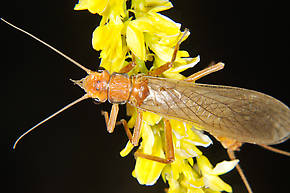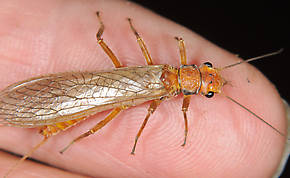Blog & Latest Updates
Fly Fishing Articles
Insects by Common Name


Stonefly Species Hesperoperla pacifica (Golden Stone)
Taxonomic Navigation -?-
Kingdom
Animalia (Animals)
» Phylum
Arthropoda (Arthropods)
» Class
Insecta (Insects)
» Order
Plecoptera (Stoneflies)
» Family
Perlidae (Golden Stones)
» Genus
Hesperoperla (Golden Stones)
» Species pacifica (Golden Stone)
Common Names
| Match | Common Name |
| Golden Stone | |
| Big Golden Stone | |
| Willowfly |
Older anglers with an extensive background fishing in the Rockies often refer to them as Brown Willowflies or simply "Willows". Historically, Golden Stonefly was a name used on the West Coast to describe members of the family Perlidae (it seems everything from California was gold back then). While in the Rockies, Willow fly was the common name settlers and ranchers used. Over time, the most prominent species on the coast, Calineuria californica became universally accepted in angling literature as the Golden Stone, while Hesperoperla pacifica as the most prominent species in the Rockies was usually listed as Brown Willowfly. In 1955 in Matching the Hatch, Ernest Schwiebert wrote that this species is partially responsible for the "willowfly" hatches of the West, and he described some Colorado mating flights as "really a spectacle to see." Even late into the '80's popular angler entomologies such as Rick Hafele's "Western Hatches" made this distinction. The name Willowfly has largely been dropped from the lexicon of the latest generation of anglers, at least when referring to this species. In an interesting twist of irony, it is Hesperoperla pacifica that now bears the scientific common name Golden Stonefly - not Calineuria californica.
The nymphs have prominent anal gills making them easy to tell apart from Calineuria. They are also often less dramatically marked and have an hour glass or similar shaped mark running vertically on the front of their heads. The more somber appearance holds true for the adults as well. The male adults of Calineuria and Hesperoperla are easier to tell apart by looking at their hammers (Hammer: A smooth clearly defined chitinous area on the ventral surface of the ninth abdominal segment of some male stoneflies used for drumming up mates.). Both are quadrangular but Hesperoperla is wider than long.
Where & When
It is important in the West.
Pictures of 8 Stonefly Specimens in the Species Hesperoperla pacifica:
Female Hesperoperla pacifica (Golden Stone) Stonefly Adult View 13 PicturesMy blurry photo at first makes it look like there might be a distinct notch in the subgenital plate of this specimen, but that's not the case -- just a poor photo. That's important to the ID.
View 13 PicturesMy blurry photo at first makes it look like there might be a distinct notch in the subgenital plate of this specimen, but that's not the case -- just a poor photo. That's important to the ID.
 View 13 PicturesMy blurry photo at first makes it look like there might be a distinct notch in the subgenital plate of this specimen, but that's not the case -- just a poor photo. That's important to the ID.
View 13 PicturesMy blurry photo at first makes it look like there might be a distinct notch in the subgenital plate of this specimen, but that's not the case -- just a poor photo. That's important to the ID.Collected July 2, 2019 from the Gallatin River in Montana
Added to Troutnut.com by Troutnut on July 18, 2019
Added to Troutnut.com by Troutnut on July 18, 2019
Male Hesperoperla pacifica (Golden Stone) Stonefly Adult View 1 Pictures
View 1 Pictures
 View 1 Pictures
View 1 PicturesCollected June 17, 2011 from the Grande Rhonde River in Washington
Added to Troutnut.com by Bnewell on June 26, 2011
Added to Troutnut.com by Bnewell on June 26, 2011
Female Hesperoperla pacifica (Golden Stone) Stonefly Adult View 1 PicturesFly fishermen refer to this stonefly as one of "golden stones".
View 1 PicturesFly fishermen refer to this stonefly as one of "golden stones".
 View 1 PicturesFly fishermen refer to this stonefly as one of "golden stones".
View 1 PicturesFly fishermen refer to this stonefly as one of "golden stones".Collected November 30, 1999 from the Grande Rhonde River in Washington
Added to Troutnut.com by Bnewell on June 26, 2011
Added to Troutnut.com by Bnewell on June 26, 2011
Your Thoughts On Hesperoperla pacifica:
Top 10 Fly Hatches
Top Gift Shop Designs
Eat mayflies.
Top Insect Specimens
Miscellaneous Sites
Troutnut.com is copyright © 2004-2024 Jason
Neuswanger (email Jason). See my FAQ for information about use of my images.
 privacy policy
privacy policy
